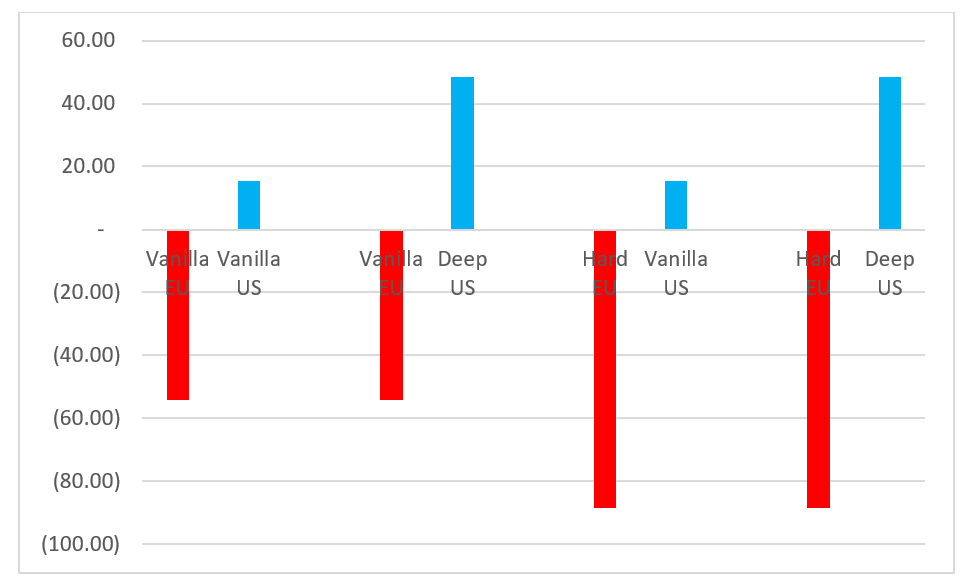Come up Trumps? The implications of a UK-US free trade agreement

President Trump’s state visit has once again brought the question of a UK-US Free Trade Agreement (FTA) back into the headlines. The US administration has on previous occasions expressed its readiness to begin negotiations with the UK. And in early 2019, the US Trade Representative’s office released its negotiating objectives. The breadth and depth of these negotiating objectives appeared to take the UK by surprise, especially as they called for far-reaching changes in regulation in areas such as agriculture and services. Statements made prior to the state visit that the US would want to place access to healthcare on the table caused further angst.
The call for a FTA comes at a time at which the US approach to trade policy has become overtly protectionist. In addition to engaging in a trade and commercial war with China, the US unexpectedly announced duties on Mexico. The measures are allegedly in retaliation against perceived inaction on the flow of people across the US’ southern border, and go against a painstaking renegotiation of the North American Free Trade Agreement. As we have observed elsewhere, the US’ actions have not only disrupted international trade, they have also degraded the multilateral system of trade rules underpinned by the WTO.
US or them?
As far as the UK is concerned, the UK-US FTA issue sits alongside the question of its future relationship with the EU. They are interdependent because whatever agreement the UK comes to with the EU will have an impact on how far it can negotiate with non-EU members such as the US. If the UK were to enter into a customs union with the EU and implements the EU’s common external tariff, it will not be able to negotiate on tariffs with the US unless the the UK and the EU jointly negotiate with the US. It may be able to negotiate entirely on services with the US. But given that agriculture is a central part of the US negotiating objectives with the UK, this might prove difficult to pursue. And if the option is pursued it would simply incentivise the US to seek much deeper commitments for the UK on services, notably in sensitive areas such as health, audiovisual, educational and various professional services.
Setting aside the customs union and tariffs question aside, the question of regulation is likely to prove a major issue. EU and US regulatory systems differ in both principle and practice. Food safety regulation is a case in point. The EU subscribes to the precautionary principle, while the US does not. The differences between the two have been played out in disputes before the WTO on matters such as hormone fed beef and chlorine-washed chicken. Differences are found elsewhere too, from audiovisual services to data. What these differences mean is that a decision to pursue closer “regulatory alignment” with the EU will affect the extent of regulatory convergence (and therefore trade) with the US, and vice versa.
Given all this, what should the UK do? One way to answer that question is to look at the relative impacts of different FTA scenarios between the UK and the EU, and the UK and the US. Remember the UK’s starting point with the EU is a position of deep integration via its membership of the customs union and the single market. Under the terms of the withdrawal agreement and the political declaration, a replication of the status quo could be possible, but the more likely scenario is that the UK will end up with a lower level of integration with the EU. That will create trade losses. The questions are: (i) how big these losses are, and (ii) how they compare to gains from striking a FTA with the US. The answer depends on the depth of the agreements stuck by the UK with the EU post-Brexit and with the US.
For the UK’s relationship with the EU, we look at a scenario in which the UK leaves with no deal at all (“hard”) or reverts to a deal of the sort the EU currently has with non-EU members such as Canada or Korea (we label this a “vanilla” agreement). These scenarios represent the harder end of the range of Brexit scenarios, which are the ones the the current US administration is known to favour. For the UK’s relationship with the US, we look at a scenario in which the UK negotiates a “vanilla” agreement with the US, or a “deep” agreement, which involves much more substantial liberalisation and regulatory convergence, of the sort observed within the EU’s single market.
Figure 1 below presents the results, using a gravity model of trade, which is generally recognised by trade policy specialists as a key part of sensible trade modelling. The red bars give the losses to the UK associated with moving from current arrangements to a vanilla deal with the EU or hard/ no deal exit. The blue bars give the gains associated with either a vanilla or a deep agreement with the US.

We see that in no arrangement does a FTA of any depth with the US offset the losses of moving away from deep integration with the EU. Even if the UK were to negotiate a Canada-style FTA with the EU and negotiate a deep one with the US, it would still face some (small) losses. Note that even this is on the extremely optimistic assumption that the UK could negotiate and implement – on the point of leaving the EU- an agreement with US of the sort that has not been see outside the European Economic Area, the rules of which took decades to negotiate.
What trumps trade?
The debate over trade numbers should not obscure that there are far deeper issues of political economy and indeed political philosophy at play here. The reason this is the case comes back to our preceding observations about the centrality of regulation in any FTA negotiations. The reason for this centrality is that with tariffs generally being low, it is regulation that affects trade costs. Moreover, in services – where there are no tariffs per se – the debate in industrialised economies is largely about regulation. Regulation is a more complicated matter to deal with in trade negotiations. Whereas with traditional border measures, “lower is better” is true for all parties to a negotiation, the same is not necessarily true for regulation. The payoffs from regulatory reform (and convergence between countries) is heavily context-specific, and depends on hard-to-measure questions like social attitudes to risk. Changes to regulation require deep-seated reforms to institutions, which are themselves the products of political preference. For example, restrictions on advertising to children may count as a restriction to trade on audiovisual services, which if removed would liberalise trade in such services. But the rationale for such restrictions lies in cost-benefit calculus that extends well beyond the scope of trade. In the case of health services, the questions are likely to be what extent US based healthcare providers can access funds, and their freedom to set prices. In previous FTA negotiations (such as with Australia) the US asked for influence in the procurement of pharmaceuticals.
These points remind us that, beyond trade effects, what politicians in the UK need to test is the preferences of society regarding different forms of economic governance. There may be a political preference by various groups to align the UK to a more US-type mode of economic governance. But if that is so, the case should be made on points of political principle, and not on alleged economic benefits, for which the evidence is quite scant.
With friends like these …
As already observed, the calls for a UK-US FTA come at a time of overt and aggressive US protectionism. That very fact may make the prospect of the a FTA with the US seem outlandish. Moreover, given that the current US administration has shown no reticence (in the case of Mexico) of acting unilaterally despite negotiating a FTA, the UK may legitimately worry as to what actual worth the US places on treaties it signs with smaller countries.
From a US standpoint, the logic is clearer. Its actions are undermining the international trading system and the WTO – the sound functioning of which was (ironically) the working hypothesis behind proponents of Brexit in its harder forms. In making the WTO part of a a “WTO Brexit” less viable, and in calling for a hard Brexit, the US would like to reduce the UK’s outside options. The US no doubt believes this would make the UK more likely to accede to a FTA that tilted towards the US’s interests, an outcome that in any event would have been likely given the inherent asymmetries between the parties. The US appraisal of the UK’s position is probably correct, and explains the brazenness of its recent pronouncements on what it knows are hot-button political issues like healthcare.
For the UK, beyond the issues raised above, the main challenge is that it has yet to work out its own approach to trade policy. With so much government capacity sucked into highly politicised Brexit negotiations, there has been little scope to think through what a trade long-term strategy on trade would look like. That in turn makes an assessment of trade agreements – which would flow from a strategy, and not be ends in themselves – more problematic. And more susceptible to capture by narrow political interests, and debate on emotive, but uninformed terms.